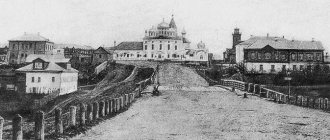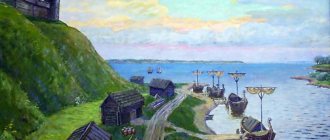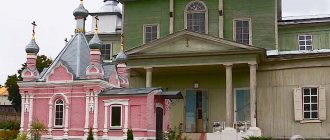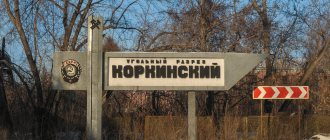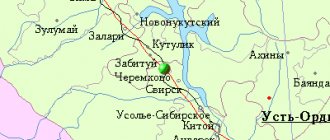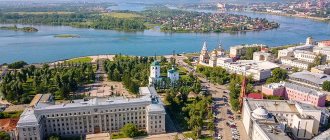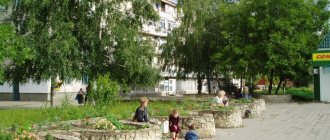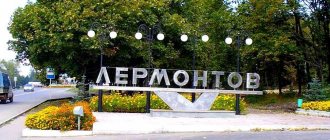Wedge
- a city of regional subordination in the Moscow region, the administrative center of the Klinsky district.
coat of arms
Population (2010) 80.6 thousand people. (1992 - 95.1 thousand, 1972 - 84 thousand, 1939 - 28 thousand, 1897 - 5.1 thousand). The city is located on the banks of the Sestra River, 65 km from the Moscow Ring Road along the Leningradskoe Highway (86 km). Railway station on the Moscow - St. Petersburg line. A narrow-gauge railway previously operated in the city and its environs, owned by. Within the city limits there is a military airfield Klin-5 ([1]), capable of receiving aircraft of almost all classes.
Locality: Klin city
- Name: Klin
- Status: city
- Number of inhabitants: 84,000
- Applies to: Urban settlement Klin
Geographical coordinates
- Latitude: 56.331621
- Longitude: 36.729151
- Klin (city) on the map
wedge
general information
Klin is an old Russian town in the Moscow region, preserving its history and traditions from the distant 14th century. It acquired its modern appearance in the second half of the last century, but it has many impressive historical and architectural monuments. The quiet provincial streets of the city have an atmosphere of charming antiquity, attracting numerous tourists. First of all, Klin is famous for its religious sites and interesting museums telling about the history of the region and famous personalities. The oldest monument is the Assumption Church of the 16th century - a rare example of Moscow ancient Russian architecture. In the central part of Klin there are Trading Rows, a monument of urban planning of federal significance, recognized as one of the best shopping buildings of the pre-revolutionary era. Nearby is the impressive Cathedral complex of the 17th – 19th centuries, which occupies a dominant position in the architectural appearance of the city. Modern Klin is a developed industrial and educational center that plays an important role in the development of the region’s economy. There are large food enterprises, educational institutions, shopping malls, shops, hotels, clubs, cafes and restaurants here.
Story
The first mention dates back to 1317 - the Nikon Chronicle says: “... In the summer of 6825... Prince Yuri Danilovich of Moscow with Kavgady and with many Tatars and with the princes of Suzdal... went from Kostroma to Rostov, and from Rostov went to Pereyaslavl, and from Pereyaslavl went to Dmitrov, and from Dmitrov to Klin.” Was part of the Tver Principality. In 1408, Edigei was ravaged by the Tatars. In 1482 Klin was annexed to the Moscow Principality. In 1569 Klin suffered greatly from the oprichnina. In 1572, Ivan IV bequeathed to his son Ivan Klin with volosts, villages and duties; later Klin was the patrimony of the Romanov dynasty. In 1617, Sokolovsky's Poles besieged the city, where Pozharsky and Dmitry Petrovich Lopata held the defense. In the 18th century, a post office was established in Klin by decree of Peter I. From 1785 - a district town in the Moscow province; At the same time, Klin acquired a regular plan. In 1851, one of the first railways in Russia, Nikolaevskaya[2], passed through Klin. Workers of Klin factories actively participated in the strike movement of 1905. From November 23 to December 15, 1941 it was in the hands of the Nazi occupiers; suffered greatly. Restored according to a new master plan. The central parish of the Klin deanery is the Church of the Icon of the Mother of God “Joy of All Who Sorrow” (Church of Sorrows). The church operates a Sunday school, an Orthodox gymnasium and correspondence theological courses. Parishioners participate in the creation of Orthodox radio and television programs. The rector of the temple is Archpriest Boris Alekseevich Balashov. Patronal feast day - the icon of the Mother of God “Joy of All Who Sorrow” (November 6, New Art).
History of the city of Klin in the XIII-XVII centuries. In those turbulent times of civil strife, lands often passed from one owner to another, and by the middle of the 13th century, Klin became part of the Tver Principality. During the Tatar-Mongol invasions, Klin, like other Russian cities, was ruined more than once, and then Moscow and Tver fought for it. By the end of the 15th century, in 1482, the city became part of the Moscow Principality and very quickly lost its military-strategic significance, since there were more powerful fortified fortresses on the western borders of the principality. However, Klin did not fall into disrepair: the city became a center of trade and craft, and the main occupation of its residents became carriage and the Yamsk postal business. In 1702, Klin, by decree of Peter I, became an official “mail pit”. Residents of Klin began serving a fairly large number of travelers. A variety of trading shops, inns, wine cellars, food warehouses and other establishments appeared in the city. Thus, meeting the needs of travelers, the city gradually stretched along the highway. The city of Klin in the XVIII-XIX centuries. In 1781, Klin received the official status of a city and a coat of arms. And in 1784, a master plan for the development of the city was developed, according to which the House of Public Places, the Mayor’s House and an almshouse were located in the center. At the turn of the 18th-19th centuries, according to the design of the landowner-architect S.P. Karin, a postal yard was built - a two-story brick building and two one-story outbuildings. Sheds for horses, a well and a stable were built here. In 1851, the first branch of the Nikolaev Railway in Russia passed through Klin, which led to a decrease in Yamsk transportation. The meaning of “stand still” has also fallen. Now a significant part of the city's population began to engage in hand weaving and make scarves, muslin, and woolen upholstery fabrics for furniture. By the end of the 19th century, Klin had turned into a quiet, provincial town. Its center also shifted somewhat, now it was represented by Cathedral Square with stone shopping arcades, a hotel, a government office and a fire tower located on it.
Transport Klin
Klin's transport network is represented by buses running throughout the city and minibuses. If desired, tourists have the opportunity to call a taxi from any hotel in the city, but it is better to negotiate the fare with the driver in advance. However, it should be noted that Klin is a small town, so it is convenient to move around its streets by bicycle or on foot.
You can get to the city via two major transport routes - by road on the Leningradskoe Highway or by train on the Oktyabrskaya Railway.
Klin city
Moscow (Klin City)
-11 °C
90 km from Moscow, on the high picturesque bank of the Sestra River, is located one of the oldest Russian cities - the city of Klin.
For a long time, debates continued among historians and local historians about which year should be considered the founding year of Klin - 1234 or 1317. It was not easy with the first documentary evidence of the founding of Klin. Historian V.N. Tatishchev argued that Klin was first mentioned in the chronicle “at the end of the twelfth century,” that is, in the 1200s. But this chronicle has not reached us. And as historically correct, historians and local historians leaned towards 1317, which dates back to the first mention of the fortified city of Klin in the Nikon Chronicle.
There are several versions about the origin of the city's name. They agree on one thing - the name of the city comes from the word wedge, which is interpreted in different ways: an acute-angled area or a sharp forest on the bank of a river, an area overgrown with forest, a border, a boundary. However, the wedge-shaped shape of the city itself speaks in favor of the first option.
Klin more than once became the site of bloody clashes in the fierce internecine struggle of the Russian principalities and was subject to invasion by foreign enemy hordes. The city was located on the border of Moscow and Tver, which waged an irreconcilable struggle for leadership, but ultimately Klin ended up as part of the “victorious” Moscow Principality (1482). Gradually the city began to lose its military-strategic importance, becoming a center of crafts and trade.
The bright and tragic pages of Klin’s history are associated with the reign of Ivan the Terrible. The devastating campaign of the formidable king against Tver and Veliky Novgorod ended for Klin with a bloody massacre of the population.
Subsequently, Klin became the patrimony of the Romanovs.
At the beginning of the 18th century, from the moment of the formation of St. Petersburg, Klin found itself on the most important route between the two capitals, receiving an incentive for economic growth. Under Catherine, the Second City received official city status and a coat of arms (1781).
At the turn of the 18th and 19th centuries, industry began to develop in the city. And in 1851, the first branch of the Nikolaev Railway in Russia passed through Klin.
The post-revolutionary period and the first years of Soviet power were marked in the city as years of growth: industry and agriculture continued to develop, cultural and educational work was carried out, and measures were taken to improve the city.
A big blow to Klin was dealt during the Great Patriotic War. During the fascist occupation, the city was destroyed: residential buildings, enterprises, and economic facilities were damaged.
The post-war and modern history of Klin is the history of a working city.
The names of prominent figures of science and culture - writers, artists, musicians, scientists - are associated with Klin and its environs.
In the first years of the revolution, the American communist writer John Reed came here. Vera Mukhina, a famous Soviet sculptor, lived in the village of Borisovo. In 1938-1941, Soviet writer Arkady Gaidar . His famous story “Timur and his team” was created using local material. In 1989, a museum . Here are the writer's personal belongings, photographs, lifetime editions of his books with the writer's autographs, and documents.
The museum is located at: Klin, st. Gaidara, 17. Open every day, except Monday and Tuesday, from 10 to 17 (the last Friday of the month is a sanitary day).
D.I. is connected with the Klin region. Mendeleev . The scientist lived and worked in the Boblovo , where, according to his plan, a manor house was built, in which Mendeleev equipped a laboratory for chemical experiments. Unfortunately, this house has not survived. Recalling the days spent on the estate, Dmitry Ivanovich’s wife wrote: “In the Boblovsky area there is something whole, complete, like in the work of a talented artist.”
The estate has preserved one of the buildings of the early 19th century, alleys and ancient parks, one of which was designed with the participation of artists A.I. Kuindzhi and N.A. Yaroshenko.
The Mendeleev Museum was founded on the estate , where documents and personal belongings of the scientist and his family, a collection of peasant household items, and a library on the history of the Russian Physical and Chemical Society are stored.
with the name of the poet Alexander Blok . In the vicinity of Tarakanovo, his grandfather was a famous botanist, rector of St. Petersburg University A.N. Beketov - purchased the Shakhmatovo estate from D.I. Mendeleev.
Leo Tolstoy came to the village of Sogolevo to visit his relatives. Here he worked on the story “Three Deaths”.
The poet Apollon Maikov spent his childhood in the Chepchikha estate.
Writer Mikhail Prishvin worked as an agronomist at a nursery for decorative natural plantings.
The scientist-physiologist K.A. lived and worked in Klin. Timiryazev. In the summer months, the “singer of ancient Moscow” artist A.M. visited here. Vasnetsov. The Klin period marks the highest flowering of the work of the Russian composer P.I. Tchaikovsky. Here he created works that were included in the treasury of world musical culture, bringing him worldwide fame.
The composer was captivated by the beauty of these places. First P.I. Tchaikovsky rented a house in the village of Maidanovo on the banks of the Sestra River in which the symphony “Manfred”, the opera “Cherevichki”, and a cycle of romances were written. Later, Tchaikovsky found housing in Frolovskoye (now the Frolovskoye railway platform within the city). Here he lived for several years, working on the operas “The Enchantress”, “Iolanta” and “The Queen of Spades”, and the ballets “The Sleeping Beauty” and “The Nutcracker”. Nowadays a museum is opened in the house of the great composer. The pride of the museum is P.I.’s piano. Tchaikovsky. The Tchaikovsky Memorial Museum is located 1.5 kilometers from Demyanovo. This is one of the most famous and visited memorial museums in the world. House-Museum of P.I. Tchaikovsky, truly the pride of Russian culture, suffered greatly during the fascist occupation. But immediately after the liberation of Klin, restoration work began, including in the House Museum. It was reopened in early 1942.
The Demyanovo estate is one of the cultural centers of Russian history, one of the oldest and most beautiful places in the Klin region, an ancient “noble nest”. It was here that the artist A. Vasnetsov, the scientist K.A. lived and worked for a long time. Timiryazev, composer S.I. Taneyev is P.I.’s favorite student. Tchaikovsky, poet A. Bely, etc. On the outskirts of the ancient park, the Church of the Assumption (1746), now operational, has been preserved.
Four kilometers from the Firsanovo railway station is Serednyakovo, where the Mtsiri sanatorium is now located. Serednyakovo once belonged to the Lermontov family.
An amazing shady park surrounding the main building, ponds and trails near the Goretovka River, spruce, pine and larch trees... The main building with belvederes and round balconies, connected by a colonnade to the side buildings, has been preserved. From the 16th to the 18th centuries, Serednyakovo was the patrimony of the Cherkasy princes. In 1775, it came into the possession of Vsevolod Andreevich Vsevolozhsky, Catherine’s nobleman, who built the main building of this magnificent estate ensemble.
It is impossible to imagine the architectural ensemble of Klin without the Assumption Church . This is the most valuable monument of the Moscow region, one of the most interesting in Russian architecture of the mid-14th century. Its peculiarity lies in the fact that none of the ancient buildings in the Moscow region that have come down to us have facades completed with three gables, like the Assumption Church.
The Resurrection Church , erected in 1712 in the “Naryshkin style,” has survived Next to it is a hipped bell tower from 1769 - an example of conservatism.
A peculiar “zest” of antiquity is the shopping arcades , built in 1886 in the pseudo-Russian style.
In Klin there is a local history museum, the exhibitions of which tell about the history of Klin, the medieval past, the Patriotic War of 1812, the construction of the Nikolaev railway, the Great Patriotic War, the industrial development of the county, its architectural appearance. A number of exhibitions present paintings, decorative and applied arts, works of folk craftsmen and artists, materials about the life and work of famous people. The museum is located at: st. Gagarina, 37/1. Open daily, from 10 to 17, except Monday and Tuesday (the last Friday of the month is a sanitary day).
Shopping in Klin
Shopping in Klin is one of the ways to occupy your free time and cheer yourself up. The city has many different shops and boutiques, as well as markets and supermarkets. Today, the city has large shopping complexes (“Daria”, “Continent” and “Schastlivaya 7ya”), providing ample opportunities for shopping and leisure activities. Guests of Klin will be interested in souvenir shops opened at the House-Museum of P. I. Tchaikovsky and the Museum of Christmas Tree Decorations. Most shops in the city are open from 9-00 to 20-00, shopping centers - from 9-00 to 21-00.
Monuments
Among the city's attractions, it is worth noting the Trinity Cathedral (1836) of the Kremlin, whose height is 25 meters. The features of the earlier Catherine era are felt in it: powerful two tiers are united by one order of pilasters, at the top there are semi-circular windows and round windows-vents. All these are typical techniques of Catherine’s era in architecture. In general, we can say that the Trinity Cathedral is a massive but compact building, has the character of noble villas. It should also be noted the railway station building, erected according to the design of K. A. Ton in the middle of the 19th century. The oldest monument of the Klin Kremlin is the Church of the Resurrection, preserved from the times when Klin was a “pit”. The church with a high hipped bell tower was built at the expense of parishioners in 1712. It was located in the Kremlin, which never had stone structures or fortifications. Its old earthen ramparts have not survived, but a deep ravine is visible that protected the approaches to the city. The church was built in the “Naryshkin Baroque” style, but the monument does not reflect this style well enough: the windows are too small, and the walls seem to swallow up the columns. One can feel the hand of a provincial master who wanted to correspond to the metropolitan trends in architectural fashion. In 1789, a three-tiered bell tower with a short tent was erected - a most curious example of conservatism. The bell tower is located in the third tier, and the first two are equipped with decorative illuminated stairs. In this building one can feel the Western European taste for massiveness, characteristic of the 16th century. The bell tower is the main vertical dominant of the city. But there are no buildings of the 17th century in the city. Assumption Church in Klin. The most ancient monuments of Klin are not located in the Kremlin, but somewhat away from it. The earliest architectural monument of the city is the Assumption Church, although the exact time of its construction is unknown. There is a legend that it was founded in 1572 in memory of the city residents who died at the hands of the guardsmen. In the middle of the 16th century, the Assumption Monastery was located on this site, and the church was the cathedral church of the monastery, which was abolished in 1761. The Assumption Church was a small single-domed structure on four pillars with corner arches. In the first half of the 19th century, a refectory and a bell tower were added to the church. At the same time, the southern and northern facades of the temple received classical porticoes in the Western European style. The building as a whole is designed in a simple provincial style. And above the dome there was an additional neck with a small head. In the early 1960s, the temple was being prepared for demolition. Moscow architects drew up the necessary document for this, according to which the monument was supposedly so rebuilt in the 19th century that it is of no interest to history. In 1963, at the request of Pyotr Dmitrievich Baranovsky, the architect Nikolai Nikolaevich Sveshnikov took care of the monument. In 1963-1966, under his leadership, based on scientific research of the monument, restoration was carried out. The restoration mainly consisted of freeing the original original elements from later cladding and strengthening the structural elements. All lost original parts and components have been restored from the surviving tail sections. Demyanovo estate in Klin. Within the city limits there is now the former Demyanovo estate, which currently houses a branch of the Klin city hospital - an anti-tuberculosis dispensary. And in the 19th century, the estate belonged to the landowner D. B. Mertvago, with whom A. S. Pushkin visited in 1811. In 1883, Demyanovo was acquired by a Russian public figure, lawyer V.I. Taneyev, brother of the famous composer Sergei Ivanovich Taneyev. The owner of the estate collected a rich library (about 20,000 volumes) and conducted extensive correspondence with prominent thinkers of his time. Composers P.I. Tchaikovsky and A.N. Scriabin, artist Apollinary Vasnetsov came to stay in Demyanovo. From 1904 to 1917, the Demyanovo estate was the summer residence of the remarkable Russian scientist and breeder K. A. Timiryazev. In 1946, on the day of the 25th anniversary of the death of V.I. Taneyev, a memorial plaque was installed on the house. In addition to the two-story house, built in the style of early classicism, the estate's Assumption Church (1746) has been preserved, which was subsequently significantly rebuilt.
Climate of Klin
The climate of Klin is moderate continental, characterized by mild winters and fairly warm, humid summers. The average annual precipitation is 660 millimeters, most of it falls in July. The warmest month is July (average monthly temperature - +23°C), the coldest month is January (-6°C). Wind speed in Klin usually ranges from 3 to 7 meters per second, but can sometimes exceed 15 to 17 meters per second. The most favorable time to visit the city is from June to September.
Internet and mobile communications in Klin
The largest cellular operators in Russia offer their services in Klin: MTS, Megafon, Beeline, as well as Cantricom and Yota. The range of their activities covers mobile communications, SMS messages and high-speed Internet. In addition, Internet access is provided through several local Internet providers. All operators have different tariffs and a huge selection of conditions for Internet access. Suppliers guarantee fairly high connection speeds, as well as stable operation of subscriber and central equipment. There are several internet cafes in the city; free WI-FI is available in some cafes, restaurants and hotels.
